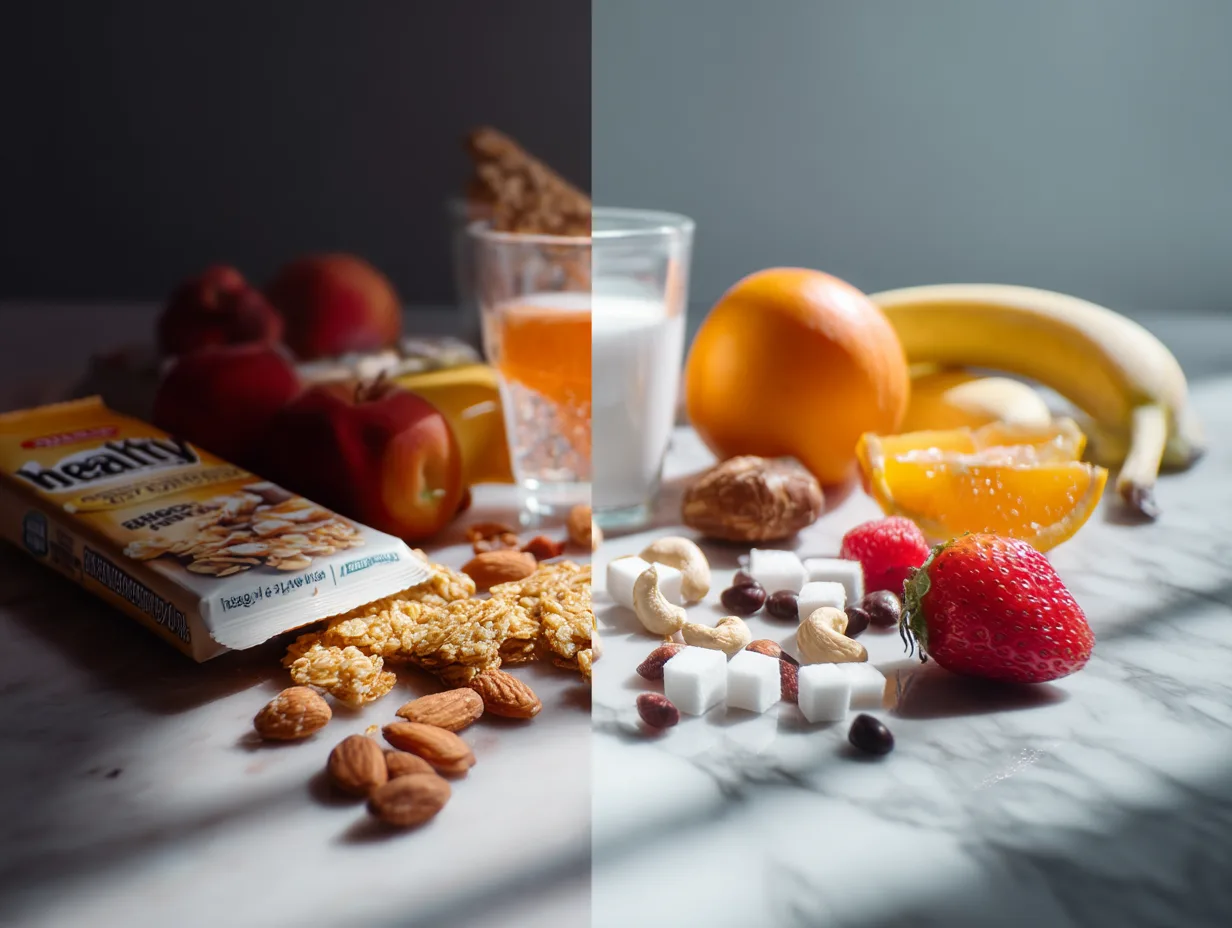Choosing nutritious foods is crucial for managing diabetes, yet not all products labeled as “healthy” are as beneficial as they seem. Many of these items contain added sugars, which can derail your blood glucose levels and undermine your overall health goals. Understanding Hidden Sugars in “Healthy” Foods for Diabetics is essential to making informed decisions, controlling carb intake, and maintaining steady blood sugar. This guide uncovers common culprits, explains how to read labels effectively, and shares tips for crafting a diabetes-friendly eating plan—without sacrificing flavor.
Why Hidden Sugars Pose a Problem
Sugars that aren’t obvious—or clearly stated—on nutrition labels can lead to unexpected spikes in blood glucose. Even if a product boasts enticing claims like “low-fat” or “no high-fructose corn syrup,” it may still be packed with other sweeteners that raise your carb count.
- Blood Sugar Spikes: Added sugars can cause quick elevations in glucose, forcing your body to produce more insulin. Over time, this can exacerbate insulin resistance.
- Weight Management: Sugars add empty calories and can lead to weight gain, which further complicates blood sugar control.
- Misleading Health Claims: Marketers often highlight certain nutrients or remove certain “bad” ingredients while quietly compensating with added sugars.
For help developing a broader meal strategy that supports stable blood sugar, take a look at our post on Diabetic Meal Planning on a Budget. You’ll find wallet-friendly tips that also align well with reducing your sugar intake.
Common Hidden Sugars in “Healthy” Foods for Diabetics
Even products typically perceived as wholesome can pack in extra sugar. Here are a few examples to watch out for:
1. Flavored Yogurts
- What’s Hidden: Many flavored yogurts feature high-fructose corn syrup or cane sugar to enhance taste.
- Better Choice: Go for plain Greek yogurt and add fresh berries or a small drizzle of honey if needed.
2. Granola and Energy Bars
- What’s Hidden: Ingredients like brown rice syrup, agave nectar, or fruit juice concentrates can significantly increase sugar content.
- Better Choice: Check for bars with fewer than 5 grams of sugar per serving, or consider making your own with whole oats and nuts.
3. Fruit Juices and Smoothies
- What’s Hidden: While fruit contains natural sugars, many juices and smoothies include added sweeteners. Even 100% fruit juice can spike blood sugar if consumed in large amounts.
- Better Choice: Eat whole fruit for more fiber, or dilute juice with water.
4. Cereals (Even “Whole Grain” Versions)
- What’s Hidden: Sugar can appear under various names like “malt syrup,” “dextrose,” or “evaporated cane juice.”
- Better Choice: Look for cereals with at least 5 grams of fiber and fewer than 6 grams of sugar per serving.
5. Salad Dressings and Sauces
- What’s Hidden: Ketchup, barbecue sauce, and certain salad dressings often rely on sugar to amplify flavor.
- Better Choice: Choose low-sugar condiments or make your own with vinegar, lemon juice, herbs, and minimal sweeteners.
Learn about other categories of foods that might affect your glucose levels in our post on How to Reverse Prediabetes with Diet. While it focuses on early intervention, the insights apply equally to managing advanced diabetes.
Deciphering Ingredient Lists and Nutrition Labels
Reading labels thoroughly can be your best defense against hidden sugars in “healthy” foods for diabetics. Key points:
- Check Total Carbohydrates: Focus on both the sugar content and the total carbs per serving.
- Scan the Ingredient List: Added sugars might go by names like sucrose, dextrose, maltodextrin, honey, maple syrup, or fruit juice concentrate.
- Beware of Multiple Sweeteners: Some manufacturers use a blend of sweeteners so sugar doesn’t appear too high on the ingredient list.
- Look for Fiber: High-fiber products can help offset sugar’s impact by slowing digestion and stabilizing blood glucose.
If you’d like more tips on label reading, our piece on Carb Counting Made Simple offers a detailed breakdown of how to interpret nutritional facts and manage your daily carb budget.
Stealthy Sugars in Beverages
Drinks can be a major source of hidden sugars for diabetics. “Healthy” options that require a second glance include:
- Flavored Waters: Seemingly harmless but often infused with sweeteners.
- Iced Teas: Commercial brands might contain more sugar than soda.
- Protein Shakes: Check the label for added sugars, especially in “recovery” formulas.
A better solution? Unsweetened tea, black coffee, or flavored sparkling water without added sugar or sweeteners. Adding a slice of lemon, cucumber, or mint can boost flavor without boosting glucose.
Upgraded Alternatives: Hidden Sugars in “Healthy” Foods for Diabetics
When cutting back on sugar, your meals and snacks need not be bland. Here’s how to replace suspect items with more diabetes-friendly choices.
- Greek Yogurt with Berries Instead of Fruited Yogurt: Control the sweetness by mixing in fresh or frozen berries.
- Plain Oatmeal Instead of Instant Flavored Packets: Sweeten naturally with cinnamon, mashed banana, or unsweetened applesauce.
- Homemade Trail Mix Instead of Sugary Granola Bars: Combine nuts, seeds, and a small amount of unsweetened dried fruit.
- Fresh Vegetables Instead of Sweet Sauces: Top salads with olive oil and vinegar instead of bottled dressings.
Check out our Low-Glycemic Snacks That Actually Taste Good post for additional inspiration on creating flavorful, diabetes-friendly snack options.
Cooking with Less Sugar: Tips for Diabetics
Reducing hidden sugars means more than just scanning labels. Adjust your cooking methods:
- Use Natural Flavor Enhancers: Herbs, spices, garlic, and onions can impart depth without added sugar.
- Marinate Wisely: Swap sugary marinades or glazes for vinegar-based or citrus-based alternatives.
- Leverage the Air Fryer: A great way to cook foods to crisp perfection without relying on sugar-heavy sauces. Explore more recipes in the Diabetic Air Fryer Cookbook.
- Experiment with Sweetness Levels: If a recipe calls for sugar, try using half the recommended amount or replacing it with a low-GI sweetener.
Sample Day of Low-Sugar Meals
Breakfast
- Option: Plain Greek yogurt with berries, flaxseeds, and a light sprinkle of cinnamon
- Reason: High protein, fiber, and minimal added sugars
Lunch
- Option: Salad of mixed greens, sliced chicken breast, bell peppers, and homemade vinaigrette (olive oil, vinegar, a dash of mustard)
- Reason: Fresh ingredients, no hidden sugars, balanced macros
Snack
- Option: Celery sticks with no-sugar-added peanut butter
- Reason: Healthy fats and protein, no refined sugar
Dinner
- Option: Salmon with roasted broccoli and cauliflower, seasoned with herbs
- Reason: Lean protein, high-fiber veggies, no sweet sauces
For more budget-friendly approaches to meal planning, reference our article on Diabetic Meal Planning on a Budget, which includes tips for stretching your food dollar without compromising blood sugar control.
Addressing Cravings for Sweetness
Cravings can be powerful, but they don’t have to sabotage your progress:
- Go Slow: If you’re accustomed to sugary foods, gradually reduce how much you use, allowing your taste buds time to adapt.
- Opt for Fruit: Natural sweetness in fruit typically comes with fiber and vitamins, making it a more diabetic-friendly choice.
- Try Herbs and Spices: Vanilla extract, nutmeg, or cloves can bring sweetness without actual sugar.
Staying on Track and Seeking Support
Identifying hidden sugars in “healthy” foods for diabetics is an ongoing process, but you can succeed by:
- Maintaining a Food Diary: Track what you eat to identify sneaky sugar sources.
- Continuous Learning: The food industry evolves quickly, so stay updated on new product formulations.
- Consulting Professionals: A registered dietitian or certified diabetes educator can provide tailored advice.
- Regular Glucose Monitoring: Keep an eye on how different foods affect your blood sugar.
For expanded insights into reversing early-stage blood sugar issues, explore our post on How to Reverse Prediabetes with Diet. Though focused on prediabetes, its tactics also apply to long-term diabetes management.
Key Takeaways: Hidden Sugars in “Healthy” Foods for Diabetics
Recognizing and avoiding hidden sugars is essential for effective diabetes management. While some “healthy” packaged items might appear low in fat or high in vitamins, they can still be loaded with sweeteners that disrupt blood glucose control. By reading labels carefully, favoring whole foods, and honing cooking techniques, you can circumvent these pitfalls.
Remember, small adjustments—like switching from flavored yogurt to plain or trading sugary sauces for herbs and spices—can lead to significant improvements in your daily carb intake. Pairing these efforts with consistent exercise, portion control, and routine blood sugar checks forms a comprehensive plan for managing diabetes effectively.


Leave a Reply